Dolphins are aquatic mammals that need to breathe air through their blowholes, just like whales. They are small-toothed and live in marine habitats all over the world.
They are most commonly found in harbors, bays, gulfs, and estuaries, as well as in coastal waters close to shore, deeper waters over the continental shelf, and even far offshore in the open ocean.
They are frequently regarded as highly social and intelligent creatures with human-like personality traits.1
Although there have only been a few confirmed instances of violence between dolphins and people, these big wild animals are nevertheless capable of hurting humans.
They may become aggressive when accosted or perceive a threat to their group.
Keep reading to learn more about this sleek animal with a permanent grin plastered on its face.
Scientific Classification
| Kingdom | Animalia |
| Phylum | Chordata |
| Class | Mammalia |
| Order | Cetacean |
| Family | Lipotidae, Platanistidae, Iniidae, Delphinidae, and Pontoporiidae. |
| Genus | Delphinus |
| Species | D. delphis |
| Scientific name | Delphinus delphis |
Characteristics
| Height | 2m – 4m |
| Weight | 80kg – 300kg |
| Venom/Poison | No (Except for the bottlenose, which has recently been found to have toxic substances in its body, dolphins generally lack venom) |
| Skin Type | Smooth, firm, and rubbery |
| Habitat | Ocean or brackish waters, freshwater, streams, rivers, gulfs, coastal waters |
| Range | Worldwide |
| Diet | Carnivore |
| Lifespan | 10yrs – 29yrs (Although certain species can live up to 90 years) |
| Gestation Period | 10 to 28 months (depending on the species) |
| Conservation status | Near threatened (not extinct) |
5 Interesting Facts About Dolphins
1. Dolphins are extremely intelligent, like humans
Popularly called the “brainiacs” of the water, dolphins and whales are renowned for their extraordinary intelligence.
Like humans, they are intelligent and smart ( as their behavior suggests); according to the latest recent intelligence measurements, dolphins are among the most intelligent animals in the world.
They have some of the largest brains in the animal kingdom compared to their size. Like other large-brained creatures, they have complex social behavior, a longer lifespan, and an ability to interpret emotions.
They’ve shown that they can pick up new information fast, impart knowledge to others, imitate, solve issues, show empathy, be self-aware, etc.
Additionally, they possess a unique echolocation ability that permits them to discern amazing details in their environment.
These creatures may spy on one another’s pregnancies and hear what other members are gazing at by listening to their echolocating noises.
They employ this skill to hunt and find their way through the muddy or dark water.
2. They turn off half their brains while they sleep
Dolphins have a unique way of sleeping. They cannot sleep the way humans do because they must remain cognizant throughout their whole slumber.
They are so unlike humans, who are completely unconscious and unaware of their surroundings.
They only allow one-half of their brains to sleep at a time; the other half remains awake so that they can continue breathing and watch out for danger in the environment. This prevents them from drowning or suffocating.2
When they sleep, they only close one eye; the left eye will be closed when the right side of the brain is sleeping, and vice-versa.
Unihemispheric slow wave sleep, often known as catnapping, is a type of sleep in which dolphins and other cetaceans, including manatees, eared seals, and some birds engage in.3
3. Dolphins are chatty animals
Dolphins are referred to as chatty marine creatures. They are well-known for possessing the animal kingdom’s most sophisticated acoustic abilities.
They can whistle, squeak, click, squawk, moan, bark, grunt, and yell from birth. They can also mimic the noises of other creatures, like whales and gulls.
According to scientists, dolphins may use certain noises to alert others of danger, engage in cooperative hunting, or distance themselves from undesirable groups.
4. They give birth to their young tail-first
Dolphins give birth to their young alive rather than laying eggs. Their pregnancies can last anywhere from 10 to 18 months, depending on the species.
The calf is born tail-first, in contrast to most mammals (although head-first deliveries are not uncommon.)
By doing this, the chance of drowning and suffocating during birth is reduced.
This tail-first delivery is because a dolphin calf is born with an umbilical cord that enables it to breathe while still in the womb, and it emerges tail-first to avoid the cord from getting in the way.
5. Dolphins are fast swimmers
A dolphin can swim in the ocean at top speeds because of its streamlined and elegant physique. Its fast roaming speed is between 8 and 10 mph, and its efficient traveling speed is between 4-6 mph.
However, they can occasionally reach gusting speeds of 16 to 30 mph when not in danger or on the hunt.
Since air has less drag than water, they conserve energy by jumping out of the water.
Porpoising or breaching is when dolphins start jumping out of the water to move faster. They might move considerably more quickly if a wave is coming up behind them. 4
General Description
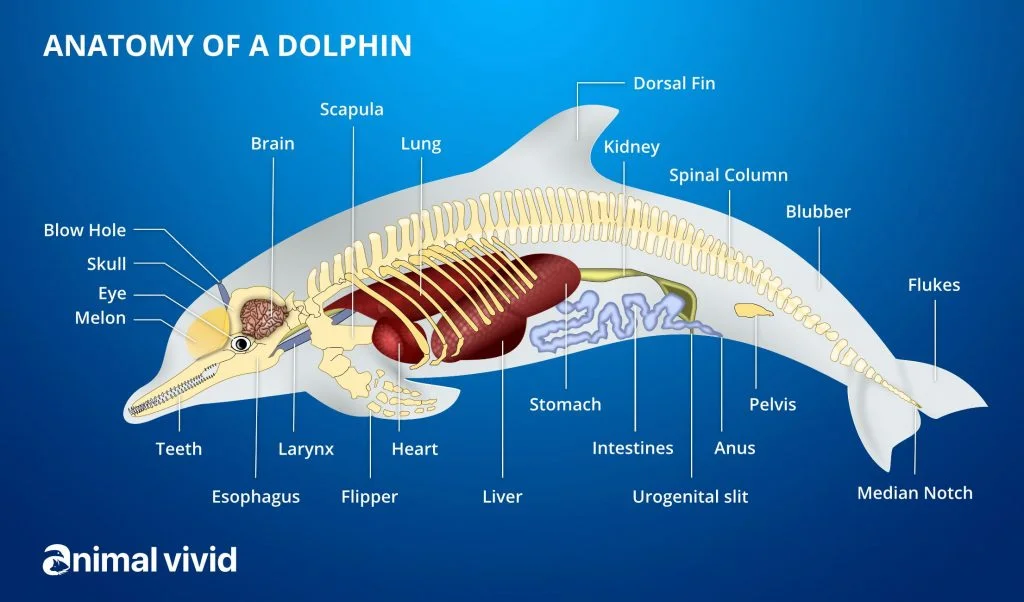
Dolphins are small-toothed mammals classified in the same scientific order called “Cetacea” as porpoises and whales.
There are 17 different genera and about 40 species of dolphins. They can be discovered in oceans or coastal brackish waters worldwide.
Depending on the species, a mature dolphin can grow to 8 or 9 feet long and weigh between 419 and 575 pounds.
They have a body shape referred to as fusiform, which is streamlined and torpedo-like. They can navigate the water at amazing speed thanks to their streamlined bodies.
Their backs range in color from light gray to dark gray, and white on the undersides and under the mouths.
Although the calves are born with hair that eventually comes off as they grow, their skin is smooth and hairless.
The dolphins’ skin constantly flakes and peels to replace old skin cells with new ones. The sloughing process guarantees a smooth body surface, which also improves swimming performance.
The thickness of the blubber that makes up a dolphin’s body changes depending on the environment.5
The main purpose of this blubber is insulation from severe weather; it can also aid in buoyancy, some degree of protection (predators would find it difficult to penetrate through a thick coating of fat), and energy for leaner times.
The melon is the spherical area on the dolphin’s forehead. It is fatty and essential to echolocation – a sort of sonar used by fish to see while swimming beneath the waters.
In front of the melon, there is a distinct projection that resembles a snout, and it is called a rostrum.
The rostrum is a structure that is normally 7 to 8 cm long and distinguished by a lateral wrinkle.
The blowhole, also known as the spiracle, through which the dolphin breathes, is situated on the dorsal surface of its head and is covered by a muscle flap that creates a water-tight seal.
Dolphins have 130 permanent conical teeth that are not intended for chewing but rather for gripping prey.
They have eyes that may move independently on the sides of its head, close to the corners of its lips. Its curving mouth gives it a perpetual smile, and immediately recognizes it.
They also have excellent vision above and below the water, but their vision only extends approximately 15 feet; so they rely on echolocation to fill the remaining distance.
Dolphins lack genuine ear holes or apertures via which they can hear. Instead, they use the tiny openings behind their eyes to “listen.” They can hear at frequencies ten times higher than those of an adult human.
They have fins instead of arms and legs, which aids in their stability. One of the simplest ways to tell them apart from sharks and other fish species is by looking at their tail form and function.
Their tails move up and down to help them travel through the water. They have fluke tail fins, which are used for communication and movement. It attaches to the rest of the body via the peduncle area, which is muscular.
Additionally, dolphins have short and inflexible forelimbs called pectoral flippers, which are not utilized for forward propulsion but allow the animal to turn and regulate speed in the water.
Because they are active predators, dolphins may consume a wide range of fish, squids, and crustaceans like shrimp. Their segmented stomachs let them digest food quickly.
They would consume whatever was offered to them in their environment due to their adaptable feeding behavior.
They are highly intelligent beings that exhibit empathy, teamwork, and kindness, and are social animals with a strong sense of community.
They can communicate with other dolphins by blowing bubbles through their blowholes and producing sounds from air sacs below the blowhole.
Even though they have a reputation for being friendly and are generally not hazardous, they are still wild creatures and can still act erratically.
Dolphins have occasionally been observed acting aggressively toward humans. So, if you ever decide to “swim with the dolphins,” be sure to follow strict instructions and stay safe.6
Distribution and Habitat
Dolphins can be found in both tropical and arctic waters all around the world. However, unlike whales, they prefer warmer climates.
The bottlenose dolphin is one of the most well-known species; it prefers warm, temperate waters with water temperatures between 50 and 90 degrees Fahrenheit.
Others are confined to specific locations, for instance, Hector’s dolphin (Cephalorhynchus hectori) which resides on the New Zealand continental shelf.
Different species have different habitat requirements and preferences. And because they consume a lot of food, they frequently reside in locations with access to a plentiful supply of food, including deep waters.
Many species migrate; spending their summers in one location before moving on to warmer climes as the season changes and the waters start to cool.
Where dolphins spend their time depends on the migratory patterns of their main food source. They can also adapt their migration to changes in the distribution and occurrence of their prey.
Diet
As carnivores, dolphins consume other animals. A dolphin’s diet is influenced by its habitat and available food sources.
Being opportunistic feeders, most dolphins consume the fish and other creatures that live in their habitats. They frequently consume fish, squid, shrimp, jellyfish, and octopuses.
The types of fish and other animals that dolphins will readily consume depend on the species, its habitat, and the wildlife around it.
They frequently prefer fish, although they may eat seaweed, shellfish, other invertebrates, and even rocks.
While larger dolphins hunt seals, sea lions, other member species, and even whales and sea turtles, smaller dolphins will consume fish like sawfish, herring, cod, and mackerel, as well as squids or other cephalopods.
Whatever their preferred meal is, their feeding habits might change based on their habitat and the available resources.
Usually, the type of fish they hunt determines how much fish they consume. For instance, squid lacks fat, while mackerels and herring do.
As a result, dolphins need to consume more squid to satisfy their desire and provide the energy they need to lead active lives.
More than 40 different types of freshwater fish and freshwater crustaceans are known to be consumed by Amazon river dolphins.
Fisher dolphins consume krill, jellyfish, and fish, while dusky dolphins consume a variety of species, including tiny anchovies, squid, and shrimp.
Deep oceans are home to rough-toothed dolphins that feed on squid. Commerson’s dolphins will eat tiny fish, crabs, octopuses, and other crustaceans in kelp beds near the shore and seafloor.
The diet of orcas is based on the food available to them where they reside and the hunting methods they have learned from their elders.
Some orcas are experts at consuming larger prey, such as seabirds and mammals like sea lions, dolphins, and whales.
The largest dolphin species is an orca, and orcas that live there only consume fish, with salmon being their favorite type.
Blue whales, like baleen whales, use their tongues and, occasionally, their neck muscles to retrieve their prey from seawater as it flows through or is driven through their baleen plates. They consume fish, copepods, and tiny crustaceans called krill.
Fun fact: Despite having teeth, dolphins don’t chew their food; instead, they simply grab, bite, and swallow!
Reproduction and Mating Process
The intricate process by which new offspring or individuals are produced is known as dolphin reproduction or dolphin mating.
Dolphins only have calves every 3 to 5 years, and they reproduce through internal fertilization.
They engage in sexual activity all year long to establish and preserve social ties. Dolphins also practice polygamy, which means they can have multiple sex partners.
Male dolphins mature sexually between 8 and 10 years, while female dolphins mature sexually between 5 and 13 years, depending on the species. Ovulation is a sign of female sexual maturation.
These marine mammals can have more than one potential mate, which makes their sexual selection extremely violent and competitive.
The males start the mating courtship with vocalizations and complex swimming patterns, and they go so far as engaging other males in combat to attract a female’s attention.
The females frequently choose a male due to his bodily size and behavioral dominance.
They have been observed to copulate using the underside of their bodies. On the underside of their bodies, males have a retractable penis that escapes through the urogenital slit.
To maximize the chances of successful reproduction in the ocean, the penis can also rotate and grapple.
They have their testis kept inside the body for temperature regulation and can discharge sperm numerous times per hour.
The male’s penis can attach to the female’s reproductive tract in seconds, releasing sperm.
For nursing females, they have a urogenital slit with mammary slits on either slide. The mammary slits serve as their inverted nipples.
Two uteri, often known as wombs, are also part of the female reproductive system with numerous tissue folds.
Since dolphins are mammals and viviparous animals, they give birth to their young alive.
They reproduce sexually in a fast, violent, and intricate manner, with the females selecting a male partner before mating (sexual selection leads to a contest in which males compete to win over females with vocalizations, gifts, and other displays of dominance.)
All marine mammals typically have one young at birth, and they provide that single baby with enormous care.
If a mother dolphin had more than one calf at birth, it is doubtful that she’d be able to provide all of them with the care they would need to live.
Predators and Threats
Many threats that dolphins face are difficult or impossible to overcome. While certain risks might frighten and stress them, others might result in their becoming stranded and even dying.
The majority of challenges they face are anthropogenic, which means that human action is to blame for the threat’s emergence.
These anthropogenic and natural risks include sickness, trauma from watercraft collisions, chemical contaminants, maritime debris, interactions with fisheries, noise pollution, and climate change.
Dolphins are a fantastic source of nutrition for predators that prowl the ocean because of their extraordinarily high-fat content.
However, they are more trouble than they’re worth, and most predators, including sharks, learn to stay away from dolphin pods.
Humans are, without a doubt, the main dolphin predators. These marine animals have few chances to live because of humans’ existence on Earth.
Both directly and indirectly, our commercial actions put the lives of these cetaceans in danger.
Behavior
Dolphins are highly intelligent animals. Within the animal kingdom, they carry out uncommon behaviors and sophisticated movements that denote intelligence.7
They establish and live in social colonies known as pods to safeguard and defend themselves against predators.
When one is hurt, the others assist one another by providing physical assistance and carrying the victim to the surface where it can breathe.
They are extremely social animals who require interaction to hunt, reproduce, or defend themselves. They also have a strong sense of community.
Their activity is constant throughout the day. However, they are most active in the morning and afternoon periods.
Their behavior is influenced by their environment, time, physiological state, and year’s season (breeding, mating, etc.).
Dolphins do not sleep the same way as people do. They maintain one cerebral hemisphere active while the other rests because they need to be partially aware to reach the surface and breathe (they must periodically ascend for air because they cannot breathe in water.)
Some species travel in a nearly straight line from one location to another. They can go alone or with other individuals, swimming on the water’s surface to conserve energy from the friction of the water against the submerged body, to get a better sense of direction, or to get rid of parasites in their skin.
Dolphins are known for their endearing and inquisitive personality. They are docile and friendly around people.
They also have close relationships with their kind, help the injured ones, work together to eat and survive, and even voluntarily approach divers and swimmers.
Male vs. Female
Male dolphins are referred to as “bulls” and female dolphins as “cows.” The male and female look remarkably similar, making it easier to distinguish between the sexes than one might immediately think.
They are almost the same length. Female bottlenose dolphins normally measure between 89 and 144 inches in length, a little different from mature males, which typically measure between 96 and 150 inches.
The males are notably larger and generally weigh twice as much as the females. They weigh about 1100 pounds, compared to the 550 pounds that women typically weigh.
However, there are other differences between the sexes besides size.
The way that the two sexes reproduce is another obvious distinction. The urogenital and anal openings, as well as, if a female, the mammary slits, are other distinguishing characteristics.
Small, rudimentary mammary slits are also possible in males. However, they are not as noticeable as in females.
The females form alliances primarily to obtain food resources, and their association with the males appears to be primarily linked to a reproductive goal.
The males work in groups to find partners to herd and mate with and collaborate to defend against others looking to take the females.
Unlike male dolphins, female dolphins rarely display aggression. They are more tolerant than the males.
The simplest technique to determine whether a dolphin is male or female is by locating the slits by the tail. It is a male if there are two slits. It’s a female if there are three slits.
Frequently Asked Questions
What characteristics do dolphins and humans share in terms of personality?
Dolphins and humans share many aspects of personality, even though they evolved in a very different environment than primates and their last common ancestor, which lived around 95 million years ago, according to a recent study.
Over 100 dolphins from acros the world were studied by researchers, who discovered that these intelligent, curious, and social creatures share many of the same personality qualities as people.
In particular, the scientists discovered openness and a feature that combines extraversion and agreeableness which is associated with curiosity and sociability to be traits shared by dolphins and humans.
Why are dolphins so intelligent?
Dolphins are intelligent creatures. They have evolved to have highly developed brains and live in complex social groups; this plays a huge role in their intelligence.
These cetaceans have brains larger than dogs, making them significantly smarter, and they exhibit traits very similar to those of humans.
They have the third-largest and most sophisticated brain after humans and apes, and as a result, their personality and behavior have long appealed to the interest of researchers and experts.
Why can’t dolphins breathe underwater?
For animals like humans, breathing is an automatic, unconscious process; nevertheless, dolphins have different breathing mechanisms.
They make conscious decisions about when to breathe and when not to because they know that inhaling too much or too little might be harmful.
Breathing underwater will open up the dolphin’s blowhole and flood it with water. This can either kill it or cause it to drown.
Are dolphins mammals or fishes?
Although they spend their entire lives in the ocean, dolphins are mammals, not fishes. They have warm blood, much like all mammals. They use their lungs for breathing air rather than the gills that fishes have.
Dolphins are also viviparous, meaning they give birth to live young rather than lay eggs, and they feed their young milk, distinguishing them from fish and making them mammals.
Final Thoughts
Dolphins are intriguing animals; so many humans find their behavior fascinating. They have been observed interacting and playing with humans; they are playful, curious, and quick-witted.
The fact that they assist others and that they have no regard for their safety or benefit makes them even more fascinating.
This article goes into great detail about this cetacean; its description, distribution, habitat, diet, reproduction and mating process, predators and threats, behavior, etc.
Latest Dolphins Articles
References & Notes
- Nunny, L., & Simmonds, M. P. (2019). A Global Reassessment of Solitary-Sociable Dolphins. Frontiers in veterinary science, 5, 331. https://doi.org/10.3389/fvets.2018.00331.
- Rachel N. (2012). Dolphins Sleep With Only Half Their Brain at a Time. [online] Smithsonian Magazine.
- Mascetti G. G. (2016). Unihemispheric sleep and asymmetrical sleep: behavioral, neurophysiological, and functional perspectives. Nature and science of sleep, 8, 221–238. https://doi.org/10.2147/NSS.S71970.
- D. Weihs. (2002). Dynamics of Dolphin Porpoising Revisited. Integrative and Comparative Biology, Volume 42, Issue 5. Pages 1071–1078, https://doi.org/10.1093/icb/42.5.1071.
- Elizabeth P., (2000). No Blubber About Blubber. [online] AAAS.
- Lauren L. Aggressive dolphin attacks are on the rise as 10-year-old is mauled on family holiday. [online] The Sun.
- Joshua R., (2021). Just How Intelligent Are Dolphins? [online] Discover Magazine.
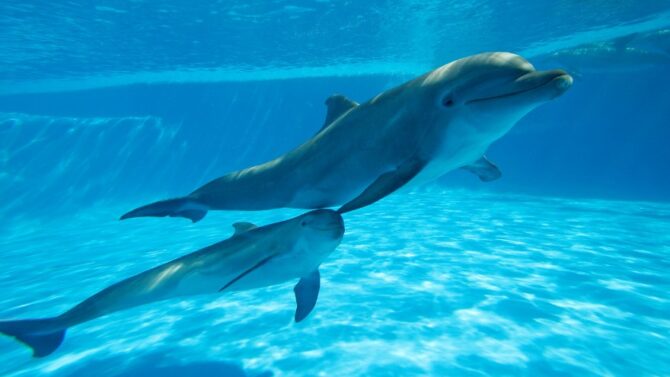
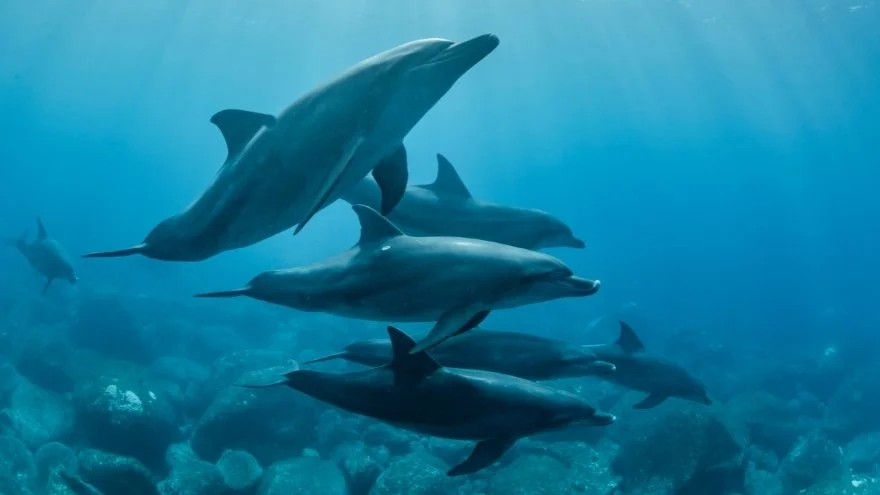
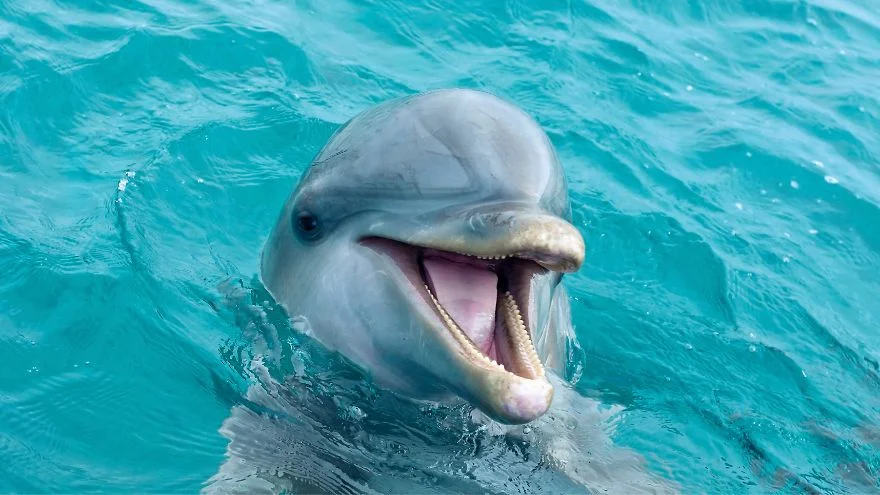
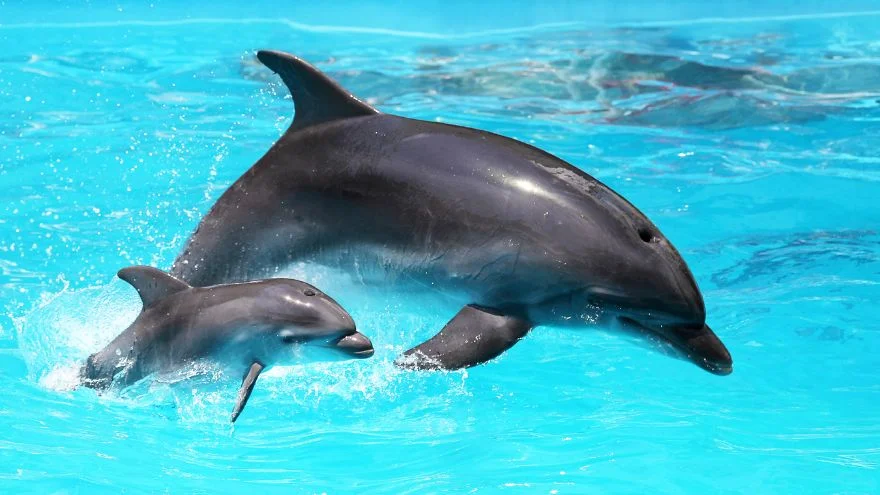
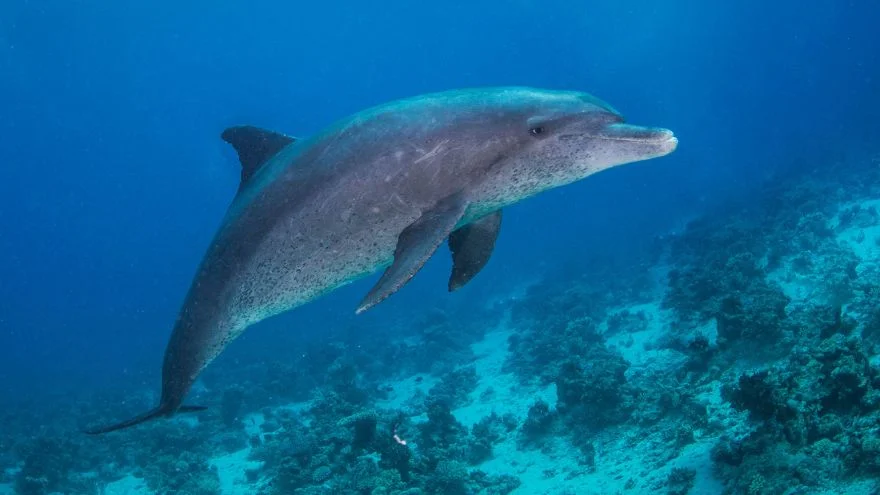
![How Long Can A Dolphin Stay Out Of Water [Answered]](https://animalvivid.com/wp-content/uploads/2022/08/How-Long-Can-A-Dolphin-Stay-Out-Of-Water-Answered.jpg.webp)